Plant of the Month: October 2009
|
| Yellow-horn Tree |
| Xanthoceras sorbifolium Bunge 1833 |
SAPINDACEÆ; Soapberry Family
|
| Since about 1985 the Yellow-horn Tree fascinated me. Its scientific name begins with an X --one of few to do so. It unites foliage recalling mountain ash (Sorbus), flowers like horse-chestnut tree (Æsculus Hippocastanum), and nuts like a macadamia. It grows like a sumach --a large shrub or small tree. It is attractive, admirably cold-hardy, drought-tolerant, and tough. But it remains undeservedly rare and little known. The main obstacle is that it has high transplant mortality. It also is sensitive to too much moisture, too much shade, too little summmer heat, and is easily hurt by coral-spot fungus. But when content, it is well content; and then it is both splendidly beautiful in bloom, and useful in fruit. |
| In Seattle, specimens have lived and died at Washington Park Arboretum. I first saw a Yellow-horn, about 12 feet tall, in a Seattle garden. It is still alive, and perhaps 50 years old; in 2005 it measured 15.5 feet tall, its trunk about 3 inches thick. In 2004 I planted a 5-gallon specimen in another Seattle garden, and now show you its bright yellow fall color photograph below. It has yet to bloom. I also show a photo below of one in a third Seattle garden, both in bloom and in fall color. But all of these pale in comparison to a tree planted by Kristan Johnson, near Port Ludlow. His Yellow-horn is far larger, and I show a photo of it. And thanks to Kristan, I also share two photos he provided of its husks and nuts. |
| The tallest Yellow-horn I have read about anywhere was 26 feet; one was 23 feet tall with a trunk 1 foot in circumference at Trengwainton, Cornwall, England (1987). Another was 13 feet tall with a trunk 2 foot 11 inches in circumference in Paris, France (1982). Thus this tree is a small enough to fit in restricted spaces. |
| The genus Xanthoceras consists of only 1 species, a deciduous shrub or small tree. The name was derived from the Greek xanthos, yellow, and keras, horn --because there are yellow-orange horn-like appendages (projecting glands) between the petals. Related genera include Koelreuteria (Golden rain tree) and Sapindus (Soapberry). |
| English names are: Yellow-horn. Shinyleaf yellow-horn. Chinese flowering-chestnut. Hyacinth shrub. Popcorn shrub (flowers resemble popped corn). Northern Macadamia. Its transliterated Chinese name --or the name of its nut, precisely-- is rendered thus in various books: Wen guan guo, Wen kuan kuo, Wen kuan kou, Wên kuang kuo. |
| It is from north and NE China. Some sources claim Korea, too, but though cultivated there, it is not listed in the Korean Plant Names Index. It has been cultivated since the 1820s in Russia. It was named in 1833 by the German botanist Bunge, who accompamed a Russian mission which traveled overland from St. Petersburg to Peking (Beijing). The specific epithet is from Latin Sorbus, Mountain ash, and folium, a leaf. In books and catalogs you will find it spelled both sorbifolia and sorbifolium. It seems that the latter is now in favor. |
| Yellow-horn was introduced from China to France in 1866, when the French missionary Armand David sent it to the Jardin des Plantes, in Paris. Shortly thereafter it was in North American commerce. An "especially hardy strain" has been developed at Green Acres Nursery in Golden, Colorado, and marketed as 'Psgan' or Clear Creek®. If you search on the Internet you can find various mail-order nurseries selling Yellow-horn. But because it is touchy about transplanting, be wary. |
| Yellow-horn is prized for its wonderful flowers, and elegant bright green foliage. Usually a stiff-branched, spindly shrub, eventually it can become a small tree; it can form colonies by root suckering. The bark is like Black locust (Robinia Pseudoacacia). Remarkably, its leaves, flowers, and seeds are all edible. The leaves are pinnately compound, 5 to 12 inches long, of 9 to 17 slender, shiny, sharply toothed leaflets; the terminal leaflet is often deeply 3-lobed. It flowers in April and May, as the leaves unfold, the lovely 6 to 10 inch tall flower clusters appear: mildly fragrant, white, first with yellowish-green, then red centers after pollination. An isolated tree can still fruit. The autumnal fruit is a top-shaped husk or capsule up to 2.5 inches, resembling a fig or thornless buckeye husk, containing very dark, half-inch seeds. It splits into three sections when ripe. It is prudent to pick them before they fully open, thus preventing the nuts from falling out when harvesting. |
| From a severe continental climate, Yellow-horn is heat-loving; exceptionally cold-hardy and drought tolerant. It is adapted to alkaline soils. It can bloom as early as the third year after being raised from seed. It is difficult to transplant successfully. According to P.J. van Melle, it has "long, rather fleshy roots with fibrous developments mostly at the ends. It must therefore be dug carefully, obtaining the full length of the roots, in the spring. Balling and burlapping is not likely to result in the rentention of the root-ends." page 119; Shrubs and Trees for the Small Place; 1955. In regions with late spring frosts it likely will be hurt. |
| Currently it is being cultivated extensively as an oilseed bearing tree, to make biofuel. If squirrels do not eat the seeds first, humans certainly should. I have yet to try, and believe that roasting them is usual, though Kristan Johnson and his wife report that the nuts taste fine raw. I have a young seedling in my Seattle garden. It is not the first time --but is the first specimen that has not died. I think Seattle has a horrible climate for this species, so it will bloom later here, and it will do best against a west or south wall, to get reflected heat. If you know of any thriving specimens in Seattle, I will appreciate learning about them. |
Yellow-horn has been used in medicine "for the treatment of rheumarthritis, rheumatic calor internus and dermal rheumatism, and was recorded in the Chinese Pharmacopoeia in 1977." In Jamuary 2007 Tony Liu applied for a patent: "The present invention discloses a kind of Shinyleaf yellowhom extract mainly consisting of Shinyleaf yellowhom total saponins, which accounts for more than 5 0% of the total weight of the dried Shinyleaf yellowhom extract. The present invention also provides a method for preparing the above extract, as well as its use in the treatment of the urinary incontinence and frequent micturition due to senile dementia or urinary bladder degradation, children enuresis, pediatric mental retardation, brain aging, middle-aged and senile dementia and Parkinson's syndrome. The pharmaceutical preparations of the present invention include injections, tablets, capsules, soft capsules, oral liquid, drop pills, etc."
Back |
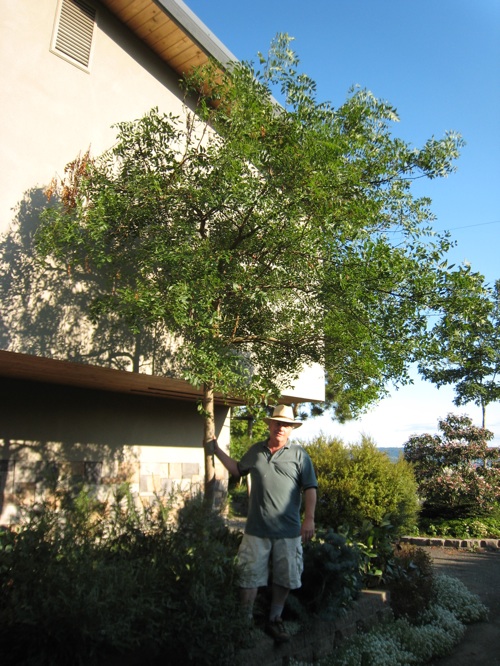
Kristan Johnson's Yellow-horn; photographed August 31 2008 by ALJ
|
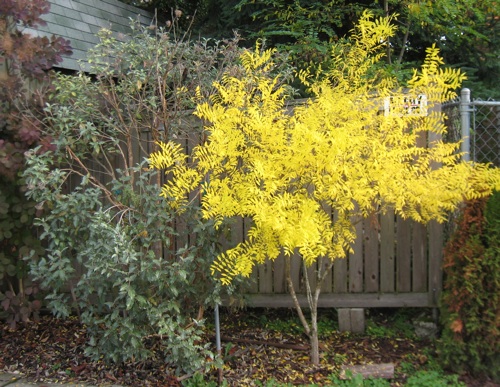
Fall color of a Yellow-horn planted in 2004; photographed October 18 2009 by ALJ
|
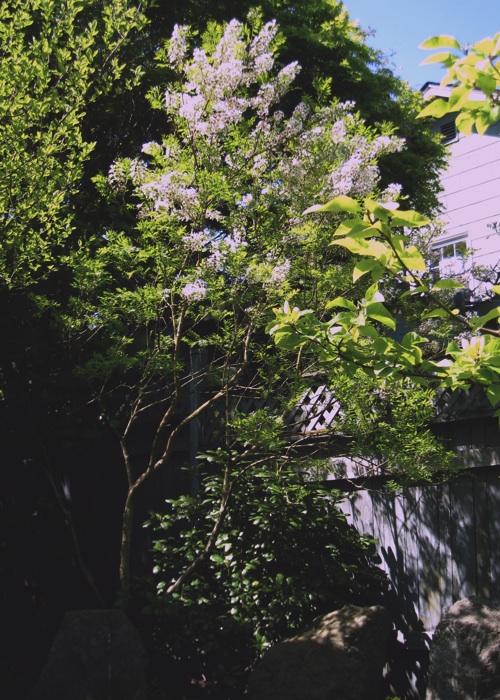
Blooming Yellow-horn; photographed May 22 2009 by ALJ
|
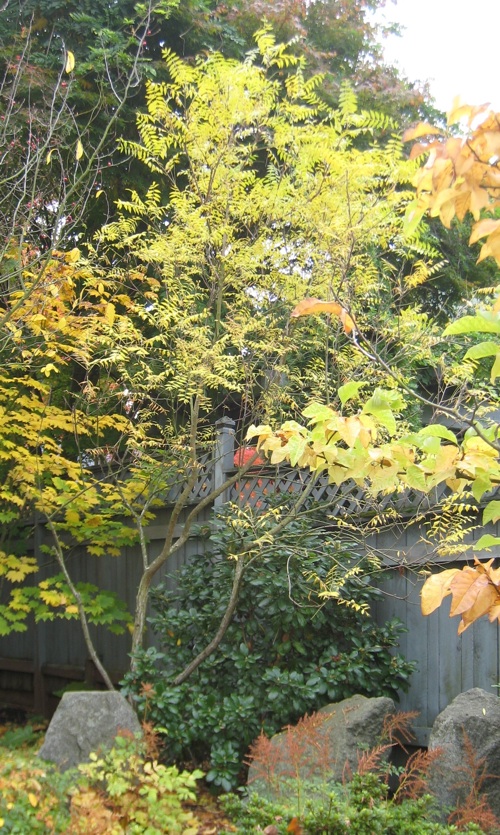
Fall color of a Yellow-horn; photographed October 22 2009 by ALJ
|
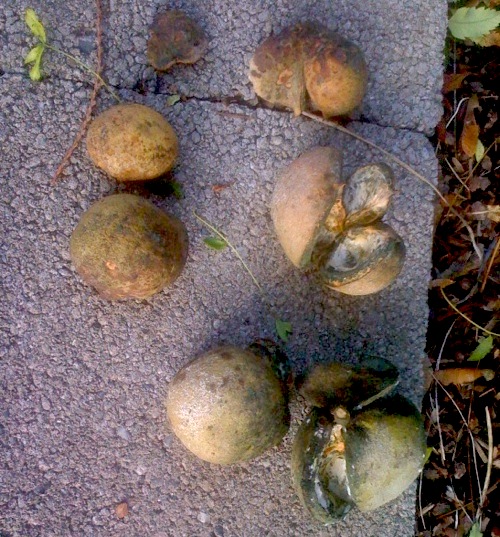
Fruit husks of Yellow-horn; photographed October 19 2009 by Kristan Johnson
|
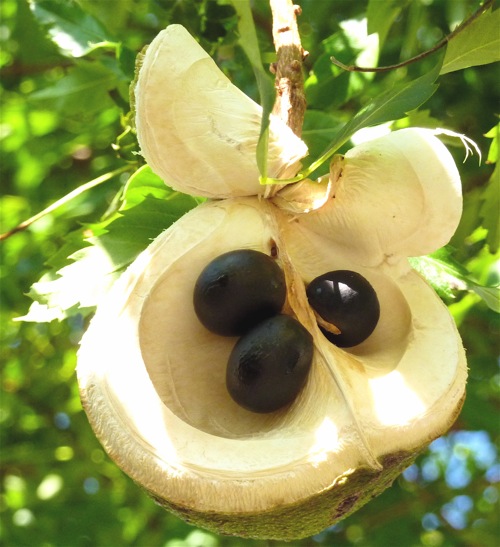
Nuts of Yellow-horn; photographed by Kristan Johnson
|
|
|

